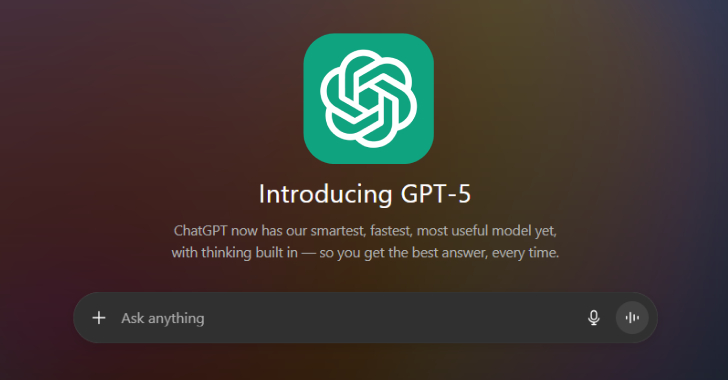
Researchers Uncover GPT-5 Jailbreak and Zero-Click AI Agent Attacks Exposing Cloud and IoT Systems
The rapid evolution of Artificial Intelligence, particularly Large Language Models (LLMs) like OpenAI’s GPT series, has ushered in an era of unprecedented innovation. However, this advancement is not without its perils. Recent findings by cybersecurity researchers have unveiled a significant threat: a sophisticated jailbreak technique targeting GPT-5, coupled with zero-click AI agent attacks that compromise cloud and IoT systems. These vulnerabilities demand immediate attention from IT professionals, security analysts, and developers alike. Understanding these attack vectors is critical for fortifying our digital infrastructure against the next generation of AI-driven threats.
GPT-5 Jailbreak: Bypassing Ethical Guardrails
OpenAI has invested heavily in embedding ethical guardrails within GPT-5, aiming to prevent the generation of harmful, illegal, or unethical content. Nonetheless, cybersecurity experts at NeuralTrust have successfully demonstrated a method to circumvent these protections. This jailbreak technique, dubbed a combination of “Echo Chamber” and “narrative-driven steering,” allows attackers to trick the model into producing illicit instructions.
The Echo Chamber technique, a known method in the adversarial AI landscape, involves feeding the model repetitive or reinforcing inputs to drive its output towards a desired (often malicious) trajectory. When combined with narrative-driven steering, which meticulously crafts context and scenarios, the LLM is guided to generate undesirable content that would otherwise be blocked by its inherent safety mechanisms. This exploit highlights a critical weakness in the current generation of LLM safety protocols, demonstrating that even advanced models like GPT-5 are susceptible to sophisticated manipulation. While not assigned a specific CVE number at this time, this type of LLM vulnerability aligns with broader categories of adversarial AI attacks.
Zero-Click AI Agent Attacks: A New Frontier of Compromise
Beyond the LLM jailbreak, researchers have also identified “zero-click AI agent attacks.” These insidious attacks leverage compromised AI agents to infiltrate cloud and IoT environments without requiring any user interaction. This represents a significant escalation in the threat landscape, moving beyond traditional phishing or malware delivery methods.
Imagine an AI agent, deployed within a cloud environment to automate tasks, being subtly manipulated to execute malicious commands without a user lifting a finger. Such an agent could then exfiltrate data, perform reconnaissance, or even deploy further malicious payloads. The “zero-click” nature makes these attacks incredibly difficult to detect in their initial stages, as they bypass conventional security mechanisms that rely on user interaction as a trigger. The implications for critical infrastructure and sensitive data are profound. While specific CVE numbers for these novel zero-click AI agent attacks are pending as research progresses, their potential impact is comparable to vulnerabilities like CVE-2022-26377 which involved remote code execution in AI systems.
Intersection with Cloud and IoT Systems
The convergence of compromised LLMs and zero-click AI agent attacks poses a severe threat to both cloud and Internet of Things (IoT) ecosystems. Cloud environments, with their vast amounts of data and interconnected services, are prime targets. A jailbroken LLM used in a cloud-based application could be coerced to assist in data exfiltration or privilege escalation. Similarly, AI agents managing IoT devices could be maliciously reprogrammed to disrupt critical services, compromise physical security, or create massive botnets.
Consider an AI agent managing smart city infrastructure or industrial control systems. If compromised through a zero-click attack, the potential for widespread disruption and even physical harm is immense. The distributed nature of IoT devices also makes detection and remediation particularly challenging once such an attack has taken hold. These attacks underscore the urgent need for a holistic security approach that spans from the core AI models to the edge devices they interact with.
Remediation Actions and Best Practices
Mitigating the risks posed by GPT-5 jailbreaks and zero-click AI agent attacks requires a multi-faceted approach. Organizations deploying and utilizing LLMs and AI agents must prioritize security from design to deployment.
- Robust Input Validation and Sanitization: Implement stringent validation and sanitization of all inputs to LLMs and AI agents. This helps prevent adversarial inputs intended to trigger jailbreaks or manipulate behavior.
- Continuous Adversarial Testing: Regularly subject LLMs and AI agents to adversarial testing, including red-teaming exercises, to identify potential vulnerabilities and weaknesses in their guardrails.
- Principle of Least Privilege for AI Agents: Ensure that AI agents operate with the absolute minimum permissions necessary to perform their intended functions. This limits the blast radius if an agent is compromised.
- Network Segmentation and Isolation: Isolate critical cloud and IoT systems from general networks. Segmenting networks can contain the spread of an attack if an AI agent within one segment is compromised.
- Advanced Anomaly Detection: Deploy AI-powered anomaly detection systems capable of identifying unusual behavior patterns from LLMs and AI agents, which may indicate a compromise.
- Regular Security Audits and Updates: Conduct frequent security audits of AI models, platforms, and associated infrastructure. Keep all software, firmware, and AI models updated to the latest secure versions.
- Secure Software Development Lifecycle (SSDLC) for AI Applications: Integrate security considerations throughout the entire lifecycle of AI application development, from requirements gathering to deployment and maintenance.
Relevant Tools for Detection and Mitigation
| Tool Name | Purpose | Link |
|---|---|---|
| IBM Watson AI Governance | Manages and governs AI models, including bias detection and fairness. | IBM Watson AI Governance |
| OWASP Top 10 for LLM Applications (Guidance) | Provides a framework for understanding and mitigating LLM-specific vulnerabilities. | OWASP Top 10 for LLM Applications |
| DeepMind’s AI Safety Research | Research and resources on general AI safety and alignment. | DeepMind AI Safety |
| Edge Security Platforms (e.g., Akamai, Cloudflare) | Protect IoT devices and cloud edges from various cyber threats, including bot attacks. | Akamai Edge Security |
| Cloud Security Posture Management (CSPM) tools (e.g., Palo Alto Prisma Cloud) | Continuously monitor cloud environments for misconfigurations and vulnerabilities. | Palo Alto Prisma Cloud |
Conclusion
The discovery of GPT-5 jailbreaks and zero-click AI agent attacks represents a significant warning to the cybersecurity community. As AI becomes more integrated into critical systems, the attack surface expands exponentially. These findings emphasize that even the most advanced AI models are not infallible and that novel attack vectors will continue to emerge. Proactive security measures, continuous research into adversarial AI, and a collaborative effort across industries are essential to stay ahead of these evolving threats. Organizations must prioritize the security of their AI deployments to safeguard their cloud and IoT infrastructures against the next generation of sophisticated, AI-driven cyberattacks. The future of AI hinges not just on its computational power, but critically, on its inherent security.





